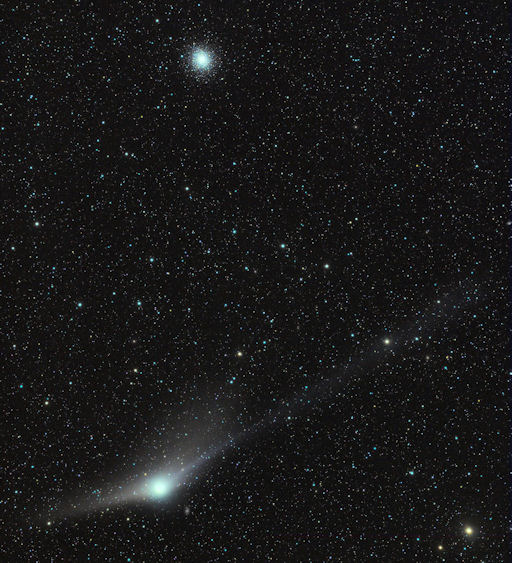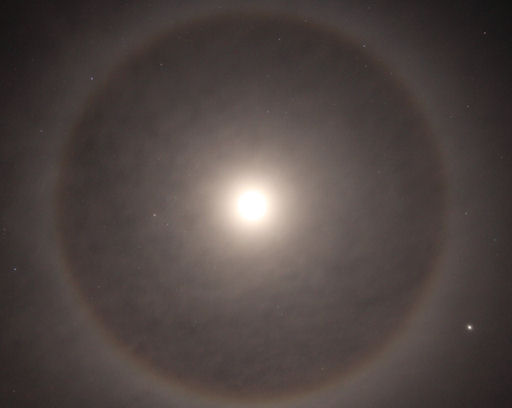QUIET SUN: Solar activity is low. None of the sunspots on the Earthside of the sun is actively erupting. NOAA forecasters estimate no more than a 1% chance of M-class flares during the next 24 hours. Solar flare alerts: text, voice.
ASTROPHOTO-OP: Astrophotographers, ready your cameras. On Friday morning, February 3rd, Comet Garradd (C/2009 P1) will pass approximately 0.5 degrees from globular cluster M92 in Hercules. On Jan. 31st, Rolando Ligustri took this picture of the converging pair using a remotely-controlled 106mm telescope in New Mexico:
The ten minute exposure shows the comet's fan-shaped dust tail, which roughly traces the comet's orbit, and its pencil-thin gas tail, which points almost directly away from the sun due to the action of the solar wind.
The star cluster and the comet are both located in the constellation Hercules, high overhead in northern hemisphere skies before sunrise. Sky and Telescope offers a sky map of the comet's path. Observers with computerized GOTO telescopes can track the comet by plugging in orbital elements from the Minor Planet Center.
At the moment, Comet Garradd has an astronomical magnitude of +6.5, invisible to the naked eye but an easy target for backyard telescopes. Forecasters expect it to brighten by a factor of ~2 in the weeks ahead as the comet approaches Earth for a 1.3 AU close encounter in early March. This could be a good time to invest in a Comet Hunter.
more images: from Lorenzo Comolli of Bogli, Italy; from Gregg Ruppel of Ellisville, MO; from Mike Broussard of Maurice, Louisiana; from Dr Paolo Candy of Ci.A.O. Cimini Astronomical Observatory - Italy
BE ALERT FOR MOON HALOES: With the full Moon less than a week away, now is the time to be alert for Moon haloes. Last night in Moray, Scotland, amateur astronomer Alan C. Tough photographed this specimen:
"I intended to photograph the Moon beside the Pleiades, but the cold and cloudy conditions were better suited to capturing this spectacular halo," says Tough.
Moon halos are formed by ice crystals in high clouds, which catch moonbeams and bend them as shown. The brighter the Moon, the brighter the Moon halo, so any halos this week should be very bright indeed. The Moon is full on Feb. 7th. Browse the links below for more examples of what's in store.

![]()
Solar wind
speed: 391.4 km/sec
density: 0.7 protons/cm3
explanation | more data
Updated: Today at 1446 UT
![]()
X-ray Solar Flares
6-hr max: B7 0907 UT Feb02
24-hr: B7 0907 UT Feb02
explanation | more data
Updated: Today at: 1400 UT
![]()
![]()
![]()
Daily Sun: 02 Feb 12
![]()
![]()
All of the sunspots on the Earthside of the sun are quiet. Credit: SDO/HMI
![]()
![]()
![]()
Sunspot number: 85
What is the sunspot number?
Updated 01 Feb 2012
Spotless Days
Current Stretch: 0 days
2012 total: 0 days (0%)
2011 total: 2 days (<1%)
2010 total: 51 days (14%)
2009 total: 260 days (71%)
Since 2004: 821 days
Typical Solar Min: 486 days
Updated 01 Feb 2012
The Radio Sun
10.7 cm flux: 118 sfu
explanation | more data
Updated 01 Feb 2012
![]()
![]()
![]()
Current Auroral Oval:
![]()
Switch to: Europe, USA, New Zealand, Antarctica
Credit: NOAA/POES
![]()
![]()
![]()
Planetary K-index
Now: Kp= 1 quiet
24-hr max: Kp= 1 quiet
explanation | more data
![]()
Interplanetary Mag. Field
Btotal: 4.6 nT
Bz: 2.4 nT north
explanation | more data
Updated: Today at 1446 UT
![]()
![]()
![]()
Coronal Holes: 02 Feb 12
![]()
![]()
Solar wind flowing from the indicated coronal hole could reach Earth on Feb. 3-4. Credit: SDO/AIA.






